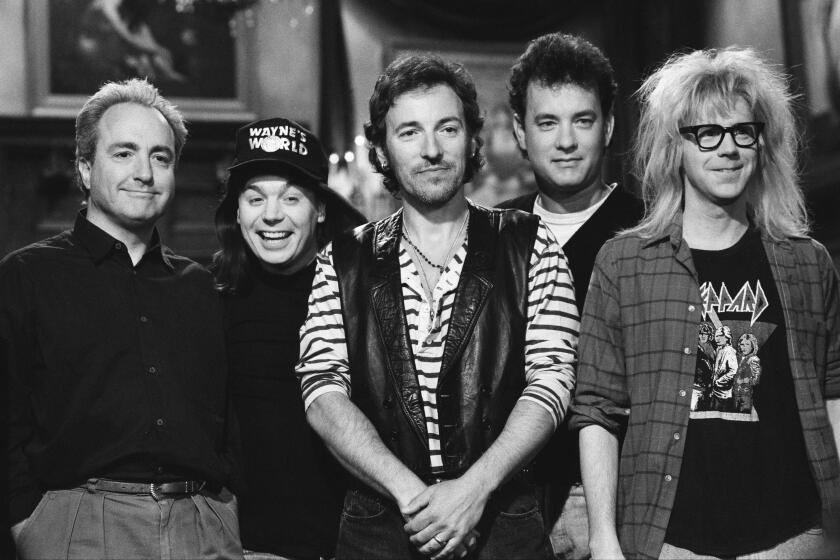Seagram Bets Billions That Vision Is Not Illusion
- Share via
Sometimes it seems that illusion, the movie industry’s stock in trade, affects big time investors and business people too.
Witness the torrent of money flowing into the entertainment industry these days, punctuated by the huge price--perhaps $7 billion--Seagram Co. is agreeing to pay for 80% of MCA, which is owned by Matsushita Electric Industrial Co.
That follows $10 billion that Viacom paid for Paramount last year and the instant blossoming of DreamWorks SKG, the company co-founded by Steven Spielberg, Jeffrey Katzenberg and David Geffen that has shot up to an apparent value of $2.5 billion months before it has a product of any kind.
Have movies and entertainment become a sure-fire, get-rich-quick business?
No, the industry is scarcely profitable, says entertainment lawyer Peter Dekom. “Costs rose 66% in the last five years and profitability has sunk to the vanishing point,” he says.
In return on shareholder investment, the business is decidedly anemic compared to most industries. The DuPont chemical company, for example, earned 22% on shareholders equity last year.
That makes it all the more remarkable that Seagram President Edgar Bronfman Jr. sold his company’s 24% stockholding in DuPont at a discount to market price last week in order to invest in MCA, which returned only 6% on investment to Matsushita last year and may return less to Seagram, which is investing more than the Japanese company did.
What madness or vision drives this game? The lure of an expanding future. Today’s enthusiasm is geography; overseas distribution now contributes half of a Hollywood film’s box office and two-thirds of a music disc’s revenues and the potential is enormous.
“China, Russia and Eastern Europe are opening up,” says a Hollywood financier. “True, there aren’t many theaters in China yet, but there will be.”
Technology is the lure of tomorrow--the age of computers and communications will provide new uses for film and video products. And that will be in the classic tradition of a business in which products are leased and not sold, never wear out and periodically find new markets. Most recently, the videocassette recorder brought the industry a new source of revenue greater than the traditional box office.
But it’s a business of dynamic, not fixed, assets. Movies, TV shows, musical numbers are not like bars of gold you put in a vault. You must find new ways to exploit the assets, as Warner Bros. did in recent years by opening stores to sell merchandise based on its old Looney Tunes characters.
“They turned those franchise characters into $2 billion in annual merchandise sales,” says an admiring Hollywood executive.
The idea for such stores occurred first at Walt Disney Co., which was in stagnation a decade ago before new management revived it. Now it is one of the strongest companies in any industry and riding the success of “Lion King,” the animated feature that has taken in roughly $800 million so far on its way to billions.
Simply put, entertainment is a business of jackpots rather than regular dividends--and of risks. The average film now costs $34 million to make and $16 million to advertise and market--a $50 million gamble on every film. It costs less to make a pop music CD, which is one reason record companies are consistently profitable.
“It’s a cash business,” explains Art Murphy, a film scholar and teacher at USC’s School of Cinema and Television. “Every morning a studio receives real cash, puts it in a safe only long enough to decide what new project to risk it on. The money is always moving around.”
Lots of cash looking for jackpots explains why actors, directors, agents, lawyers and studio heads can prosper even though reported company profits are skimpy.
But cash and deal making also gives the business an air of instability and raffishness that is misleading. The same six or seven studios (Columbia (now Sony), Disney, MCA-Universal, Paramount, 20th Century-Fox, Warner Bros. and now ailing MGM), have dominated the entertainment business for 50 years. Outsiders come in, get frightened and depart--as Coca-Cola did years ago when a $40-million loss on the film “Ishtar” pushed Coke to sell its half interest in Columbia Pictures.
Now Matsushita and Sony, Japanese buyers of five or six years ago, are departing or counting losses. Both strong manufacturers of CD players, VCRs and other entertainment hardware, Matsushita and Sony saw investments in entertainment software as natural.
But Sony was too lenient with bad managers and Matsushita perhaps too restrictive of good ones and neither has seen its vision of Hollywood fulfilled--although Sony has succeeded in music.
“It’s too bad because the Japanese were a source of capital for the business that has now become discouraged,” says Roy Salter, head of entertainment analysis at Houlihan Lokey Howard & Zukin, a Los Angeles investment bank.
Still, sophisticated business people continue to invest in movies. Sidney Kimmell, chairman of Jones Apparel Group in his day job, has backed such films as “Mr. Mom” and “9 1/2 Hours” in the past and reportedly is gearing up to produce more films.
Several leading venture capitalists--who request anonymity lest their phones ring incessantly--have pooled a couple of million dollars to back movie scripts at the first stage of film development.
In other cases corporate investors finance the completion of projects that are backed by studio contracts.
In years to come, sources of finance may broaden as Salter and other bankers devise formulas to make returns on film projects more predictable. Movies, after all, can be a conservative investment compared to currency plays and derivatives.
Meanwhile, what does Seagram, the world’s leading distiller and vintner, see in MCA? Asset values, for one thing. Seagram’s purchase--if made for $7 billion--places a value of $8.75 billion on all of MCA, and that’s not really overpriced. MCA estimates its music business alone to be worth as much as $3 billion; the MCA library of 3,000 movies and roughly 14,000 television programs is probably worth another $3 billion. The Universal Studios theme parks in Los Angeles and Orlando, Fla., could be worth $1.5 billion to $2 billion. Add in real estate and assorted other assets and MCA is an $8.5 billion to $9 billion company.
And that says nothing of the potential in those assets if energetic management can bring them alive. “You can value assets two ways,” says analyst Lee Isgur of Jefferies & Co. There’s counting numbers in a balance sheet, he says, or “there’s Ted Turner’s way” of seeing the potential.
Almost 10 years ago, Turner was derided for paying $1.2 billion for the MGM film library. But with those films, Turner was able to start both the TNT cable network and the Cartoon Network, multiplying that $1 billion a couple of times over.
Sometimes illusion and business opportunity look the same; the key to success is telling them apart.
More to Read
The biggest entertainment stories
Get our big stories about Hollywood, film, television, music, arts, culture and more right in your inbox as soon as they publish.
You may occasionally receive promotional content from the Los Angeles Times.










